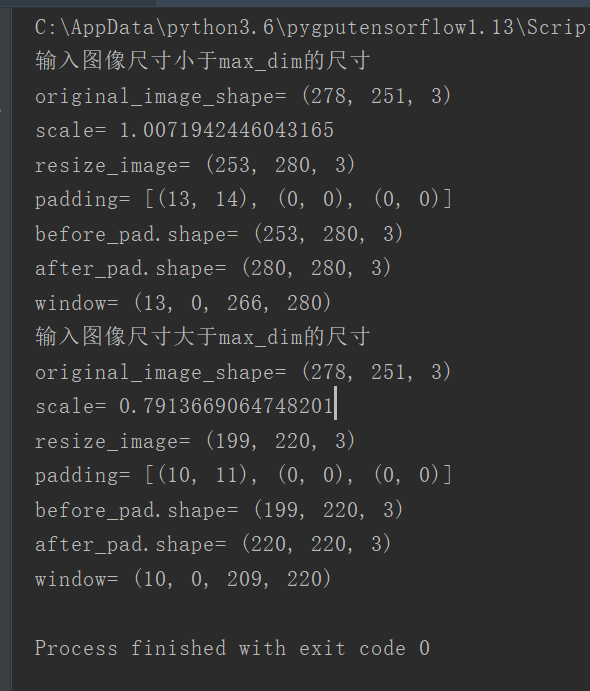mask-rcnn代码解读(六):resize_image()函数的解析
我已经根据resize_image()函数的解析对原图像与resize图像进行了解析,
若有读者想对原图像与目标图像不同尺寸验证,可根据以下代码,调整函数参数,
其细节如下:
import cv2 as cv
import numpy as np
img=cv.imread('D:\\MASKRCNN\\mask-rcnn-me\\MASKRCNN_myself\\0.bmp')
def resize_image(image, min_dim=230, max_dim=220, min_scale=2, mode="square"):
"""Resizes an image keeping the aspect ratio unchanged. min_dim: if provided, resizes the image such that it's smaller dimension == min_dim
max_dim: if provided, ensures that the image longest side doesn't exceed this value.
min_scale: if provided, ensure that the image is scaled up by at least
this percent even if min_dim doesn't require it.
mode: Resizing mode.
none: No resizing. Return the image unchanged.
square: Resize and pad with zeros to get a square image of size [max_dim, max_dim].
pad64: Pads width and height with zeros to make them multiples of 64.
If min_dim or min_scale are provided, it scales the image up
before padding. max_dim is ignored in this mode.
The multiple of 64 is needed to ensure smooth scaling of feature
maps up and down the 6 levels of the FPN pyramid (2**6=64).
crop: Picks random crops from the image. First, scales the image based
on min_dim and min_scale, then picks a random crop of
size min_dim x min_dim. Can be used in training only.
max_dim is not used in this mode. Returns:
image: the resized image
window: (y1, x1, y2, x2). If max_dim is provided, padding might
be inserted in the returned image. If so, this window is the
coordinates of the image part of the full image (excluding
the padding). The x2, y2 pixels are not included.
scale: The scale factor used to resize the image
padding: Padding added to the image [(top, bottom), (left, right), (0, 0)]
"""
# Keep track of image dtype and return results in the same dtype
image_dtype = image.dtype
print('original_image_shape=',image.shape)
# Default window (y1, x1, y2, x2) and default scale == 1.
h, w = image.shape[:2]
window = (0, 0, h, w)
scale = 1
padding = [(0, 0), (0, 0), (0, 0)]
crop = None if mode == "none":
return image, window, scale, padding, crop # Scale?
if min_dim:
# Scale up but not down
scale = max(1, min_dim / min(h, w)) # h, w是原始图片的高与宽
if min_scale and scale < min_scale: # min_scale是最小填充倍数的,至少要大于它
scale = min_scale # Does it exceed max dim?
if max_dim and mode == "square":
image_max = max(h, w)
if round(image_max * scale) > max_dim: # 最终原图片最大边扩充不能超过最大max_dim维度,否则重新选择scale
scale = max_dim / image_max # Resize image using bilinear interpolation
print('scale=',scale)
if scale != 1:
image = cv.resize(image, (round(h * scale), round(w * scale)))
print('resize_image=',image.shape)
# 上一行代码对图像做了resize,那么会改变图像的尺寸,这是我不愿意看到的,我觉的这样会对缺陷特征有损失,
# 或者出现变异,因此小心这里的变化
# Need padding or cropping?
if mode == "square":
# Get new height and width
h, w = image.shape[:2] # 此时已经将原图按照scale进行了改变
top_pad = (max_dim - h) // 2
bottom_pad = max_dim - h - top_pad
left_pad = (max_dim - w) // 2
right_pad = max_dim - w - left_pad
padding = [(top_pad, bottom_pad), (left_pad, right_pad), (0, 0)]
print('padding=',padding)
print('before_pad.shape=',image.shape)
image = np.pad(image, padding, mode='constant', constant_values=0) # 将改变的图片进行了填充
print('after_pad.shape=', image.shape) window = (top_pad, left_pad, h + top_pad, w + left_pad) # 保存经过resize后图片的真实大小
print('window=',window) return image.astype(image_dtype), window, scale, padding print('输入图像尺寸小于max_dim的尺寸')
resize_image(img, min_dim=230, max_dim=280, min_scale=2, mode="square") print('输入图像尺寸大于max_dim的尺寸')
resize_image(img, min_dim=200, max_dim=220, min_scale=2, mode="square") 结果如下:

mask-rcnn代码解读(六):resize_image()函数的解析的更多相关文章
- 使用colab运行深度学习gpu应用(Mask R-CNN)实践
1,目的 Google Colaboratory(https://colab.research.google.com)是谷歌开放的一款研究工具,主要用于机器学习的开发和研究.这款工具现在可以免费使用, ...
- [代码解析]Mask R-CNN介绍与实现(转)
文章来源 DFann 版权声明:如果你觉得写的还可以,可以考虑打赏一下.转载请联系. https://blog.csdn.net/u011974639/article/details/78483779 ...
- 论文阅读笔记三十六:Mask R-CNN(CVPR2017)
论文源址:https://arxiv.org/pdf/1703.06870.pdf 开源代码:https://github.com/matterport/Mask_RCNN 摘要 Mask R-CNN ...
- CVPR2019 | Mask Scoring R-CNN 论文解读
Mask Scoring R-CNN CVPR2019 | Mask Scoring R-CNN 论文解读 作者 | 文永亮 研究方向 | 目标检测.GAN 推荐理由: 本文解读的是一篇发表于CVPR ...
- Mask R-CNN用于目标检测和分割代码实现
Mask R-CNN用于目标检测和分割代码实现 Mask R-CNN for object detection and instance segmentation on Keras and Tenso ...
- 目标检测论文解读11——Mask R-CNN
目的 让Faster R-CNN能做实例分割的任务. 方法 模型的结构图如下. 与Faster R-CNN相比,主要有两点变化. (1) 用RoI Align替代RoI Pool. 首先回顾一下RoI ...
- 论文笔记:Mask R-CNN
之前在一次组会上,师弟诉苦说他用 UNet 处理一个病灶分割的任务,但效果极差,我看了他的数据后发现,那些病灶区域比起整张图而言非常的小,而 UNet 采用的损失函数通常是逐像素的分类损失,如此一来, ...
- Mask RCNN 源码阅读(update)
之前看了Google官网的object_dectect 的源码,感觉Google大神写的还不错.最近想玩下Mask RCNN,就看了下源码,这里刚好当做总结和梳理.链接如下: Google官网的obj ...
- Mask RCNN 学习笔记
下面会介绍基于ResNet50的Mask RCNN网络,其中会涉及到RPN.FPN.ROIAlign以及分类.回归使用的损失函数等 介绍时所采用的MaskRCNN源码(python版本)来源于GitH ...
随机推荐
- FCC---Create Visual Direction by Fading an Element from Left to Right---一个带好看背景色的圆形图案,从左到右移动,透明度opacity渐变为0.1,背景色渐渐消失的效果
For this challenge, you'll change the opacity of an animated element so it gradually fades as it rea ...
- FileZilla搭建FTP服务器
一.基础环境1.服务端机器:192.168.0.104 FillaZilla Server端下载2.客户端机器:192.168.0.100 FillaZilla客户端下载 !!!搭建FTP服务端的机器 ...
- python3+Scrapy爬虫使用pipeline数据保存到文本和数据库,数据少或者数据重复问题
爬取的数据结果是没有错的,但是在保存数据的时候出错了,出现重复数据或者数据少问题.那为什么会造成这种结果呢? 其原因是由于Spider的速率比较快,而scapy操作数据库操作比较慢,导致pipelin ...
- postman---postman自动发博客
前面写了一篇如何通过Cookies值去登录博客园,今天我们来通过登录博客园之后,我们进行通过Postman自动写博客 自动写博客 1.打开Postman.填写博客园对应的Cookies: 2.抓取编写 ...
- postman---postman参数化
我们在做接口测试的过程中,都会遇到同一个接口不同的数据,每次去一个个填写数据就太麻烦了,今天我们一起学习下如何通过postman进行参数化 参数化 参数化就是1个接口请求不同的数据,我们可以通过把请求 ...
- react中antd的表格自定义展开
antd的表格官方案例中给出的都是固定的图表展开,在做需求的时候,需要使用点击最后一列,然后出现展开内容,实现效果图如下 在最开始设置一个全局变量 const keys = [];在设置列参数的函数中 ...
- python将xml文件数据增强(labelimg)
在处理faster-rcnn和yolo时笔者使用labelimg标注图片 但是我们只截取了大概800张左右的图,这个量级在训练时肯定是不够的,所以我们需要使用数据增强(无非是旋转加噪调量度)来增加我们 ...
- celery 异步发送短信验证码、延迟任务
短信 celery.py import os, django os.environ.setdefault("DJANGO_SETTINGS_MODULE", "luffy ...
- Jike_Time-决策树
根节点 非叶子节点(决策点) 叶子节点(决策结果) 分支 熵代表混乱程度 信息增益 构造树的基本想法是随着树深度的增加.节点的熵迅速地降低.熵降低的速度越快越好,这样我们有望得到一颗高度最矮的决策树 ...
- sqlite 的去重
1) 找到重复的记录,归类到一个新表里面 max(id) 是想要删除的record 2) 删除 delete from gallery where id in ( select theid from ...
